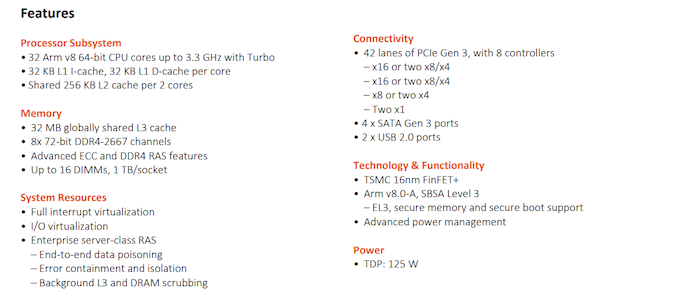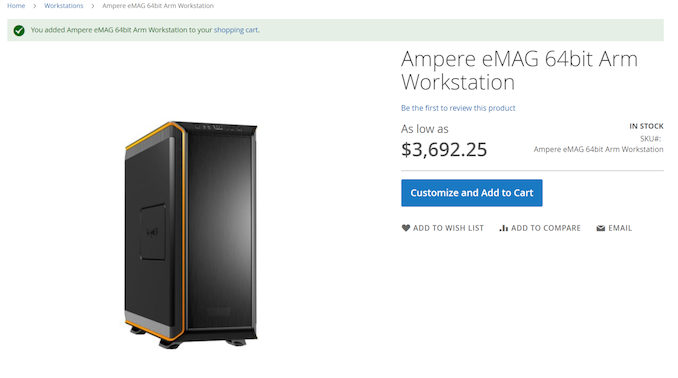Arm Server CPUs: You Can Now Buy Ampere’s eMAG in a Workstation
by Dr. Ian Cutress on December 6, 2019 12:00 PM EST- Posted in
- CPUs
- Arm
- Workstation
- Trade Shows
- Ampere
- eMAG
- Supercomputing 19
- SC19
- Avantek

One of the critical elements to all these new server-class Arm processors is availability. We are not yet at the point where these chips are freely sold on the open market: anyone who wants to use them needs to buy a server (or a rack of servers), or rent a cloud instance. One of the benefits of x86 in this space is that users can write code for x86 servers on other easily accessible hardware, then port it up to the big server iron. Well now it seems that one of the Arm licencees playing in the server space has a workstation based product in the hands of distributors ready for software developers to cut their teeth on the hardware.
Over at Avantek, the Ampere eMAG 64-bit Arm Workstation is a single socket workstation design offered in an XL-ATX chassis with up to 512 GB of DDR4-2666 as well as an NVMe drive and some SATA ports. There are onboard video outputs from the IPMI interface, or a PCIe 3.0 x8 expansion slot could add in something else (assuming drivers are available).
The workstation is only offered with a single CPU SKU, the eMAG 8180. This isn’t to be confused with Intel’s 8180: this one has more cores! The eMAG 8180 is a 32-core design running at 2.8 GHz with a turbo up to 3.0 GHz, with a TDP of 125 W. This is a first generation eMAG, which uses the old AppliedMicro Skylark microarchitecture, a custom design of Arm v8 with 32 MB of L3, 42 PCIe lanes, and eight memory channels.

Official eMAG 8180 specifications - note the frequency here is higher.
It looks like the workstation has decreased clocks
Avantek offers the system with three optional graphics cards: AMD FirePro W2100, a Radeon Pro WX 5100, and the NVIDIA Quadro GV100. OS options are variants of Linux: Ubuntu, CentOS, SUSE SLES, and openSUSE.
The base configuration requires the user to select at least a 240 GB SSD and 1x8GB of DRAM, which means a super low (!) price of $2,794.50 for the base model. Users who want a chassis with a window and LED lighting will need to shell out an extra $108, because it isn’t a proper workstation with LEDs, right?! A more sensible configuration with the W2100, 64 GB of DRAM, and 4x256GB of SSDs, comes to $4044.60. Validated purchasers can leave a review – so far none have been left. Perhaps we should ask for one for review.
Source: Avantek











19 Comments
View All Comments
Dolda2000 - Friday, December 6, 2019 - link
There's very little that would make ARM inherently more efficient than x86, it's all about the implementation and where on the voltage/frequency curve they are used in the end.Even then, though, this seems quite efficient at 125 W for 32 cores, so I'm not really sure what you'd have to complain about.
Kangal - Saturday, December 7, 2019 - link
No he's right.We don't know what type of microarchitecture they're using, but at the least efficient side we would be looking at Cortex A72 (at best it's Cortex A76). We know it isn't using a Cortex A32, A53, or A55 simply based on the clockspeed. And it actually doesn't have anything like a monstrous large cache or something to hint it's a custom larger core like Samsung's Mongoose or Apple's Lightning cores.
And I'd be willing to bet they're using 16nm node, whilst they could be using the latest 7nm fab or anything in-between like 10nm. And power characteristics of 16nm are pretty decent. So we can safely assume that in a "worst case scenario" they're running 32x 900mW x 3 / 2GHz = 43.2 Watts. That's still 45W which is in the ballpark of a thicker laptop, or a Micro Desktop/Console.
https://www.anandtech.com/show/9878/the-huawei-mat...
Remember, the Ryzen 3950X is running 16-cores, that's half as many, at the same TDP range. And that's a big fat x86 design, and not like ARM cpus.
So either this is using an outdated design (28nm? Cortex A57?) and it's running unoptimised... or the company has purposely chosen a VERY conservative TDP for ventilation/warranty purposes. For 125W TDP range, I would instead expect a 14nm Cortex A73 design running at 3.0Ghz... with a whopping 128-CORES!!
milli - Friday, December 13, 2019 - link
This is using a custom core designed for server usage so you can't compare it to any Cortex core used in a phone.On top of that you're negligently forgetting the huge memory controller, the server-class RAS features, the dozens of pci-e lanes,... And the list goes on. These things alone take a big chunk of the power envelope.
They're using 16nm because this chip was launched last year and was sampling in 2016.
MrSpadge - Friday, December 6, 2019 - link
Probably by not much if they're as fast as x86 cores and are part of a bigger system (many cores, big caches, several memory channels, many I/O ports etc.).Santoval - Saturday, December 7, 2019 - link
The CPU has 32 cores, and these are not mobile ARM cores. They are designed for servers, so they are fatter and deeper than ARM's reference designs. That node is also very long in the tooth by now. If it was fabbed at 7nm its TDP would probably be in the 65W to 70W region at the same clock.Santoval - Saturday, December 7, 2019 - link
Last gen (or two+ gens) before in just about everything : fabrication node (1.5 half gens), PCIe version, ARM ISA (two and very soon three gens; this is the original ARMv8 ISA) and USB version (two gens). The DRAM frequency is also somewhat low, but that is not an issue due to the 8 memory channels (4 cores per memory channel is quite healthy).jwittich - Sunday, December 8, 2019 - link
The CPU in this is the eMAG 8180, which is a 16nm 32-core Arm v8 custom core that was released last year. With gcc 8.2 -ofast, lto, jemalloc, SPECint_rate2017 = 59.ProDigit - Saturday, December 14, 2019 - link
Intel never really released their 128 core CPU, until after Larrabee came out. They named it the 'Xeon Phi'.Their Xeon Phis would run on Larrabee's PCIE format too, and was what I would say, the closest thing to deep learning, AI, massive computing (up to 64 cores, 256 threads).
ARM has lost the battle against GPUs.
Even the most powerful $+2k ARM CPU can't compete in data crunching to a $160 GPU running 1280 Cores at 1,4-1,9Ghz.
Nvidia and AMD basically stomped out ARM. ARM will remain small, and data center CPUs should remain big. Since they're very efficient now on 7nm nodes (and getting smaller), it makes no sense to try to make a CPU that tries to imitate a GPU.
Instead CPU makers should focus on increasing frequency per core; as nodes become smaller usually forces those cores to operate at lower frequencies.
This is important for feeding GPUs the data they need. Nvidia tries to lock 1 CPU core per GPU, as currently you'll need 3+Ghz per core, for most of the top end GPUs (RTX series GPUs).
We've recently made a huge leap in computing performance, and GPUs will now combine multiple dies on one GPU card, removing the need to occupy more than 2 or 3 PCIE 16x slots.
speculatrix - Tuesday, December 17, 2019 - link
I'd like to see a full review of this, with benchmarks.However, if you want native Arm development, you'd be hard pressed to find better value than the PineBookpPro.